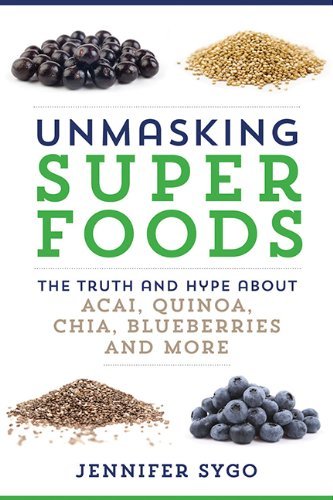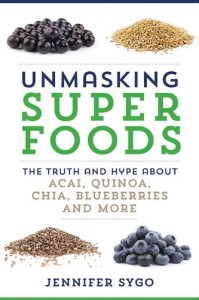Q&A: Jennifer Sygo, author of Unmasking Superfoods

 Toronto-based dietitian and National Post columnist Jennifer Sygo’s new book, Unmasking Superfoods, was released one month ago.
Toronto-based dietitian and National Post columnist Jennifer Sygo’s new book, Unmasking Superfoods, was released one month ago.
We caught up with her to talk about what the book is about, some of the foods she touches on and why all the food you need is probably at your local grocery store already.
Canadian Running: Why did you want to write the book?
Jennifer Sygo: The book is a genesis from my newspaper column with the National Post. I’ve written on a lot of different topics and sport nutrition is one of my specialty areas, but I cover a little bit of everything. We took a segment of the columns on superfoods, turned them into an ebook and it did really well, so it was a pleasant surprise that there is a demand in this area and people really want myths to be debunked. They want to get the bottom line on the stuff that they’re hearing a lot of hype about. So, the objective and the big level-headed approach to this trendy superfoods movement was to really look at it critically.
CR: What overarching theme did you find in writing the book?
JS: We have this image or mythology that certain foods are so highly nutritious and extra special that they’re worth spending $40 on for a bottle of juice or going to the ends of the earth for a particular seed, and that’s fine if money is no object, but at the end of the day we have plenty of access to really common foods here in North America — I often use carrots as can example but you could talk about blueberries or beets, oysters, mussels or collard greens — that we can eat and will gives us tons of nutrition without a massive bottom line and that there is probably a sounder research base for than some of the stuff that is so heavily hyped.
CR: Why do some of these superfoods takeoff while we overlook the more common, affordable and available foods in most grocery store produce sections?
JS: There are hype machines around this stuff. There is a lot of focus on nutrition in general on talk shows, in blogs and in magazines. When I started writing for the Post in 2007 you had to practically beg publishers to write about nutrition. It just wasn’t on peoples’ radars and now it’s gotten to the point where it’s almost dogmatic. People are looking for that single food, that silver bullet, and so you get these trends where the person with the right charisma, or some guru comes along and says that a certain type of berry will cure cancer and help you lose weight, these days we’re pretty inclined to believe that.
CR: For someone who wants to follow a generally healthier diet but don’t follow these food trends closely, what should they look to fill their grocery cart with?
Again, you want to keep it to simple foods that, at the end of the day, if it’s a single-ingredient food and something humans have been consuming a long time it’s a pretty good chance that’s a good choice. That could be nuts, seeds, beans, legumes or whole grains. I know it sounds sort of tried and tested, but that’s the reality of it. Also, maybe swapping a granola bar for an apple and reducing our reliance on processed foods.
CR: Are there some foods that do stand above others with noticeable benefits that you can’t get elsewhere?
JS: Some that I have found intriguing are avocados and beets.
Avocados which are really unusual in terms of their nutritional profile. They’re incredibly rich in potassium and fibre; they’re pretty special.
Beets have an unusual capacity, because they’re a rich source of dietary nitrates, that they can actually increase levels of nitric oxide and can help athletes like runners run faster or at a higher intensity, but with a lower perceived exertion. They’re pretty cool.
Also on my radar are oysters and mussels. Those are actually good for the environment; they clean and filter the ocean and are an incredible source of vitamin B12, selenium, zinc. Those are all nutrients that are key for athletes.
CR: What makes a food trend takeoff while these other great foods can fly under the radar?
JS: Honestly, in the media world it often just takes one person who’s a key influence to either talk about or write about those foods and what will happen is writers and editors will pickup on that and continue to write about that same food.
Kale got big a few years ago and yet, amazingly, collard greens, which are also nutritious hardly get talked about and it just takes that key personality. Dr. Oz is a good example where he talks about a certain food and it sells outs instantaneously. And that’s fine, but there are all these equally good foods get ignored.
CR: Are there problems to these superfood trends?
JS: Sure. People can be under a false impression that it will improve health and that may have never been proven true in humans. Cost can be an issue. There can be environmental concerns when we all start consuming they same food and the industry can have a hard time keeping up with production.
The other big one is what we call the ‘health halo’ effect, which is when people get the impression that, because they’ve eaten something that is perceived as being highly nutritious, they can therefore get away with more.
‘Oh, I had those goji berries and I’m really, super healthy now, so I can go and eat a doughnut.’
CR: Any other comments?
JS: I think the bottom line for runners is that they tend of be highly driven, motivated people and sometimes there’s that idea of getting the next best thing, and a lot of those next best things are actually already available, they’re just under their nose and they don’t realize it. Maybe they’ve never tried collard greens or Swiss chard before because they’re just used to eating spinach all the times, or have never tried pistachios because they’ve always been eating almonds.
It’s really just about expanding their variety of choices without having to go over the top and hunt foods down from the Himalayan mountains or the jungles of the Amazon. Oftentimes it’s right there in your grocery store.


